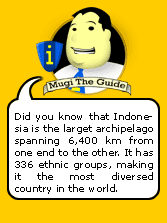|
 Indonesia has the fourth-largest population in the world, consisting of over 300 ethnic groups. Each group has its own culture, beliefs and dialect, and many live in remote or inaccessible areas. A distinction can be made between communities that have largely retained their ancient cultures and those that have been affected by outside influences. Indonesia has the fourth-largest population in the world, consisting of over 300 ethnic groups. Each group has its own culture, beliefs and dialect, and many live in remote or inaccessible areas. A distinction can be made between communities that have largely retained their ancient cultures and those that have been affected by outside influences.
The position of Indonesia on the earliest sea routes between Arabia (modern-day Middle East), India and China meant that the islands were often visited by traders. Influences from other cultures were absorbed by the communities living near the trading ports and by rules, whose courts welcomed the travellers from distant lands. New ideas from abroad were assimilate into the existing cultures to produce Indonesia's distinctive heritage. This is known as a combined culture.
Examples of ancient cultures include the Batak in Sumatera, the Badui in Java, the Dayak of Kalimantan, the Toraja in Sulawesi and the Dani of Irian Jaya. The lifestyles of these people remained untouchable for centuries and followed the same pattern as that of their ancestors. They still use some traditional laws (adat) to determine their daily activities, decision-making and ceremonies.
The Ethnography collection comprises a wide variety of objects that are part of Indonesian daily life as well as exhibits that are used in ceremonies and rituals. Also include in the Ethnography Collection is textile-made objects displayed under the category of Textile Collection. A small number of these objects have been selected to illustrate the many different cultures in the archipelago.
|